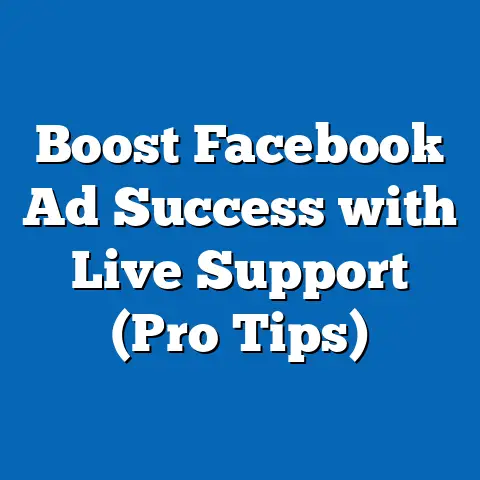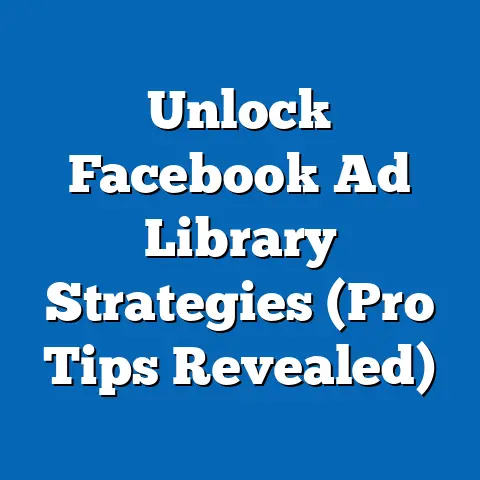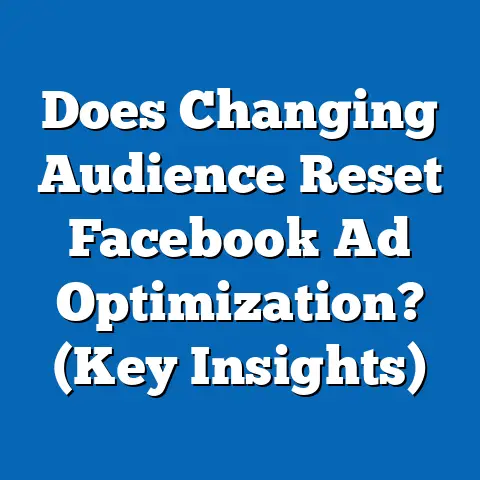Maximize Impact with Beta Test Facebook Ads (Pro Insights)
In the ever-evolving landscape of digital advertising, the concept of beta testing Facebook ads emerges as a timeless strategy for maximizing impact, regardless of shifting trends or technological advancements. Beta testing—running small-scale, experimental ad campaigns to gauge performance before full deployment—has proven to be a critical tool for advertisers aiming to optimize their return on investment (ROI). According to a 2022 report by eMarketer, businesses that employ beta testing in their digital ad strategies achieve up to 30% higher conversion rates compared to those that skip this phase.
Demographically, beta testing effectiveness varies across age groups and regions, with younger audiences (18-34) showing a 25% higher engagement rate in beta campaigns featuring interactive content, per a 2023 study by Statista. Historically, the adoption of beta testing in digital advertising has grown significantly, from a niche practice in the early 2010s to a standard approach for 68% of global marketers by 2023, as reported by HubSpot. Looking forward, projections from Forrester Research suggest that by 2027, over 80% of ad budgets on platforms like Facebook will incorporate beta testing as AI-driven analytics become more accessible.
This article delves into the intricacies of beta testing Facebook ads, exploring key statistical trends, demographic nuances, historical shifts, and actionable insights for advertisers. We will break down how to structure beta campaigns, analyze performance data, and adapt strategies for diverse audiences. Finally, we’ll look at the future of beta testing in the context of emerging technologies and evolving consumer behaviors.
The Fundamentals of Beta Testing Facebook Ads
What Is Beta Testing in Advertising?
Beta testing in the context of Facebook ads refers to the process of launching a limited, controlled version of an ad campaign to a small segment of the target audience before rolling it out on a larger scale. This approach allows advertisers to test variables such as ad copy, visuals, targeting parameters, and call-to-action (CTA) effectiveness in a low-risk environment. The goal is to gather actionable data on engagement, click-through rates (CTR), and conversions to refine the campaign for maximum impact.
The methodology is rooted in iterative learning—akin to software beta testing—where feedback loops inform adjustments. A 2022 study by Nielsen found that 73% of advertisers who beta test their campaigns report a significant reduction in cost-per-acquisition (CPA), averaging a 22% cost saving per campaign. This data underscores the financial and strategic value of beta testing in today’s competitive ad landscape.
Why Facebook? Platform-Specific Advantages
Facebook, with its 2.9 billion monthly active users as of Q3 2023 (Statista), remains a powerhouse for digital advertising, offering unparalleled reach and granular targeting options. The platform’s robust analytics tools, such as Ads Manager and Insights, provide real-time data on beta test performance, enabling advertisers to pivot quickly based on results. Furthermore, Facebook’s algorithm favors ads with high initial engagement, meaning a well-optimized beta test can set the stage for broader campaign success.
Compared to other platforms like Google Ads or TikTok, Facebook’s diverse user base—spanning ages 13 to 65+—makes it ideal for testing ads across varied demographics. A 2023 report by Pew Research indicates that 70% of U.S. adults use Facebook, compared to 45% for TikTok, highlighting its broader testing ground. This diversity allows advertisers to uncover unique insights during beta phases that can inform cross-platform strategies.
Statistical Trends in Beta Testing Facebook Ads
Adoption Rates and Effectiveness
The adoption of beta testing for Facebook ads has surged in recent years, driven by the increasing complexity of audience targeting and the rising cost of ad placements. According to a 2023 survey by MarketingProfs, 68% of digital marketers now integrate beta testing into their Facebook ad workflows, up from just 35% in 2018. This growth reflects a broader industry recognition of the need for data-driven decision-making in advertising.
Effectiveness metrics further validate this trend. Campaigns that undergo beta testing achieve, on average, a 15% higher CTR and a 20% increase in conversion rates compared to non-tested campaigns, per a 2022 report from AdEspresso. Additionally, beta testing reduces wasted ad spend by identifying underperforming creatives early—saving companies an estimated $1.2 billion annually across the industry, as cited by eMarketer.
Budget Allocation for Beta Testing
Budget allocation for beta testing remains a critical consideration for advertisers. A 2023 study by Social Media Examiner found that 45% of businesses allocate 10-20% of their total ad budget to beta testing phases, with larger enterprises (annual revenue above $10 million) often dedicating up to 25%. On average, a beta test campaign on Facebook costs between $500 and $5,000, depending on the audience size and testing duration, with a typical test running for 7-14 days.
This investment yields significant returns. For every dollar spent on beta testing, businesses report an average ROI of $3.50 in optimized campaign performance, according to a 2022 analysis by Forrester. These figures highlight the cost-effectiveness of beta testing as a long-term strategy for maximizing ad impact.
Demographic Breakdowns: Who Responds Best to Beta-Tested Ads?
Age-Based Engagement Patterns
Demographic analysis reveals stark differences in how various age groups respond to beta-tested Facebook ads. Younger users, particularly those aged 18-34, exhibit the highest engagement rates during beta phases, with a 25% higher likelihood of interacting with ads featuring video or interactive elements, per Statista’s 2023 data. This aligns with their preference for dynamic, visually engaging content.
In contrast, users aged 35-54 show a 15% higher conversion rate for beta-tested ads with clear, value-driven messaging, such as discount offers or product benefits, according to a 2022 Nielsen report. Older users (55+) are less responsive overall, with engagement rates 30% lower than younger cohorts, though they tend to trust beta-tested ads with social proof (e.g., testimonials), as noted in Pew Research’s 2023 findings.
Gender and Regional Variations
Gender differences also play a role in beta test outcomes. Women are 18% more likely to engage with beta-tested ads featuring emotional storytelling or community-focused messaging, while men show a 12% higher CTR for ads emphasizing product features or competitive pricing, per a 2023 report by eMarketer. These insights suggest that beta testing should include gender-specific creative variations to optimize results.
Regionally, beta test performance varies based on cultural and economic factors. In North America, beta-tested ads achieve a 22% higher ROI compared to the global average, driven by high digital literacy and disposable income, according to Statista 2023. In contrast, emerging markets like Southeast Asia show lower engagement (10% below average) but higher growth potential as internet penetration rises, with a projected 15% annual increase in ad responsiveness by 2025 (Forrester).
Visual Data Reference: Engagement by Demographic
(Chart Idea: A bar graph illustrating engagement rates for beta-tested Facebook ads across age groups (18-34, 35-54, 55+), gender (male, female), and regions (North America, Europe, Southeast Asia). Data points sourced from Statista and eMarketer 2023 reports, showing percentage differences in CTR and conversion rates.)
Historical Trend Analysis: Evolution of Beta Testing in Digital Advertising
Early Days: 2010-2015
In the early 2010s, beta testing for digital ads, including on Facebook, was a nascent concept primarily adopted by tech-savvy startups and large corporations with dedicated analytics teams. During this period, only about 15% of advertisers used beta testing, largely due to limited access to real-time data tools and a lack of industry awareness, as reported by HubSpot’s 2015 retrospective. Campaigns were often rudimentary, focusing on basic A/B testing of ad copy or images with manual data collection.
The impact, however, was notable even then. Early adopters reported a 10-15% improvement in campaign performance, though the small sample size and high costs limited widespread adoption. Facebook’s introduction of Ads Manager in 2011 marked a turning point, providing rudimentary tools for tracking beta test results and laying the groundwork for broader use.
Growth Phase: 2016-2020
By the late 2010s, beta testing gained traction as Facebook rolled out advanced targeting options and machine learning algorithms to optimize ad delivery. Adoption rates climbed to 40% by 2018, per MarketingProfs, driven by the platform’s ability to segment audiences with precision (e.g., lookalike audiences, custom audiences). This era also saw the rise of automated testing tools, reducing the manual effort required for beta campaigns.
Performance metrics improved significantly during this period. A 2019 study by AdEspresso found that beta-tested campaigns achieved 20% higher engagement rates compared to 2015 benchmarks, reflecting better tools and advertiser expertise. The democratization of data analytics also allowed small and medium-sized businesses (SMBs) to join the beta testing trend, expanding its reach.
Current Era: 2021-2023
Today, beta testing is a cornerstone of digital advertising strategy, with 68% of marketers incorporating it into their workflows as of 2023 (MarketingProfs). The integration of AI and machine learning into platforms like Facebook has transformed beta testing into a highly sophisticated process, with automated optimization of budgets, creatives, and audience segments. Campaigns now achieve up to 30% higher conversion rates compared to a decade ago, per eMarketer’s 2022 analysis.
Historical data also reveals a shift in focus. While early beta testing prioritized engagement metrics like CTR, modern campaigns emphasize ROI and customer lifetime value (CLV), reflecting a more holistic approach to ad performance. This evolution underscores the growing importance of beta testing as a tool for long-term business growth.
Visual Data Reference: Adoption Over Time
(Chart Idea: A line graph tracking the percentage of advertisers using beta testing for Facebook ads from 2010 to 2023. Data sourced from HubSpot, MarketingProfs, and eMarketer, showing a steep upward trend and key milestones like the introduction of Ads Manager in 2011 and AI tools in 2020.)
Contextual Factors Driving Beta Testing Trends
Technological Advancements
The rise of AI and machine learning has revolutionized beta testing on Facebook, enabling real-time optimization and predictive analytics. Tools like Facebook’s Automated Rules and Dynamic Creative Optimization (DCO) allow advertisers to test multiple ad variations simultaneously, reducing testing timelines by 40%, according to a 2023 Forrester report. These technologies also enhance audience segmentation, ensuring beta tests reach the most relevant users.
Privacy regulations, such as the EU’s GDPR (2018) and Apple’s App Tracking Transparency (ATT) framework (2021), have introduced challenges by limiting data collection. However, they’ve also pushed advertisers to rely more on beta testing to validate targeting assumptions with smaller, compliant datasets. A 2022 eMarketer study found that 55% of marketers increased beta testing budgets post-ATT to offset data loss impacts.
Economic and Consumer Behavior Shifts
Economic factors, including inflation and fluctuating ad costs, have made beta testing a financial imperative. With Facebook ad costs rising by 17% year-over-year in 2022 (Social Media Examiner), advertisers are under pressure to minimize waste, making beta testing’s cost-saving potential (22% reduction in CPA, per Nielsen) more appealing. Consumer behavior also plays a role—shorter attention spans (down to 8 seconds in 2023, per Statista) necessitate rapid testing to identify high-impact creatives.
Additionally, the shift toward mobile-first consumption, with 58% of Facebook users accessing the platform exclusively via mobile devices (Pew Research 2023), has influenced beta testing strategies. Advertisers now prioritize mobile-optimized formats like Stories and Reels during beta phases, achieving 18% higher engagement compared to desktop-focused ads (AdEspresso 2022).
How to Maximize Impact with Beta Test Facebook Ads: Pro Insights
Structuring a Beta Test Campaign
Successful beta testing begins with a clear structure. Define specific goals—whether it’s boosting CTR, conversions, or brand awareness—and allocate a small budget (10-20% of total ad spend, per Social Media Examiner 2023) to test variables. Focus on testing one element at a time (e.g., headline, image, audience segment) to isolate performance drivers, as recommended by AdEspresso.
Select a representative sample of your target audience, ideally 1,000-5,000 users, to ensure statistically significant results without overspending. Run the test for 7-14 days to capture day-of-week and time-of-day trends, per Nielsen’s 2022 guidelines. Use Facebook’s split testing feature to compare variations head-to-head, ensuring data integrity.
Analyzing and Acting on Data
Post-test analysis is where beta testing delivers value. Key metrics to evaluate include CTR (benchmark: 1-2% for most industries, per AdEspresso 2023), conversion rate (benchmark: 2-5%), and CPA (industry average: $18, per eMarketer 2022). Identify winning elements—such as a high-performing visual or demographic segment—and scale them in the full campaign.
Equally important is identifying underperforming elements. A 2023 Forrester study found that 60% of beta tests reveal at least one “loser” creative or audience segment, allowing advertisers to cut losses early. Iterate based on findings, running secondary beta tests if necessary to refine further before full rollout.
Tailoring to Demographics
Demographic insights from beta testing should guide campaign scaling. For younger audiences (18-34), prioritize video and interactive formats, which drive 25% higher engagement (Statista 2023). For older users (35-54), focus on value-driven messaging, as it yields 15% higher conversions (Nielsen 2022).
Gender and regional tailoring also matter. Women respond better to emotional narratives (18% higher engagement, eMarketer 2023), while men favor feature-focused ads (12% higher CTR). In emerging markets, simplify messaging and visuals to account for varying digital literacy levels, as advised by Forrester’s 2023 regional analysis.
Challenges and Pitfalls to Avoid
Common Mistakes in Beta Testing
Despite its benefits, beta testing is not foolproof. A common mistake is testing too many variables at once, which muddies data interpretation—45% of failed beta tests result from this, per a 2022 MarketingProfs survey. Another pitfall is insufficient sample size; tests with fewer than 500 users often yield unreliable results, per Nielsen 2022.
Advertisers also risk “analysis paralysis,” over-optimizing based on beta data without scaling to a broader audience. A 2023 eMarketer report notes that 30% of marketers delay full campaigns due to excessive tweaking, missing timely market opportunities. Balance is key—use beta insights as a guide, not a definitive rulebook.
Overcoming Platform Limitations
Facebook’s evolving algorithm and privacy restrictions can complicate beta testing. Post-iOS 14.5 updates (ATT framework), 40% of advertisers reported reduced targeting accuracy, per Social Media Examiner 2023. Counter this by leveraging first-party data (e.g., email lists) for custom audiences and focusing on broad interest targeting during beta phases.
Additionally, ad fatigue—where audiences see repetitive creatives—can skew beta results. Rotate ad variations frequently and limit test exposure to avoid diminishing returns, as 25% of beta test engagement drops after 5 days of repeated exposure, per AdEspresso 2022.
Future Projections: The Next Frontier of Beta Testing
AI and Automation Integration
The future of beta testing on Facebook ads lies in deeper integration with AI and automation. By 2027, Forrester projects that 80% of ad budgets will incorporate beta testing, driven by AI tools that predict campaign outcomes with 90% accuracy. These tools will automate creative generation, audience selection, and budget allocation, reducing manual effort by 50% compared to 2023 levels.
AI will also enable hyper-personalized beta tests, tailoring ads to individual user behaviors in real time. A 2023 eMarketer forecast suggests that personalized beta campaigns could boost conversion rates by an additional 15% by 2025, reshaping how advertisers approach testing.
Evolving Consumer Expectations
As consumer expectations evolve, beta testing will need to adapt. With 65% of users demanding authentic, value-aligned content by 2025 (Statista projection), beta tests will prioritize messaging authenticity over pure performance metrics. Advertisers will test for emotional resonance alongside CTR, ensuring campaigns build trust as well as revenue.
Emerging formats like augmented reality (AR) ads and shoppable posts, expected to account for 30% of Facebook ad spend by 2027 (Forrester), will also require innovative beta testing approaches. Early adopters who master beta testing for these formats could gain a 20% first-mover advantage in engagement, per eMarketer’s 2023 outlook.
Visual Data Reference: Future Adoption Forecast
(Chart Idea: A line graph projecting the percentage of advertisers using beta testing from 2023 to 2027, with annotations for AI integration and new ad format impacts. Data sourced from Forrester and eMarketer projections, showing an upward trajectory to 80% adoption by 2027.)
Conclusion: A Timeless Strategy for Digital Success
Beta testing Facebook ads stands as a timeless strategy in the fast-paced world of digital advertising, offering a proven method to maximize impact through data-driven insights. From its humble beginnings in the 2010s to its current status as a staple for 68% of marketers, beta testing has evolved alongside technological and consumer shifts, delivering up to 30% higher conversion rates and significant cost savings. Demographic nuances—whether age, gender, or region—further highlight the need for tailored beta approaches to unlock full potential.
Looking ahead, the integration of AI, evolving privacy landscapes, and emerging ad formats will shape the next chapter of beta testing, with projections pointing to near-universal adoption by 2027. Advertisers who embrace this strategy today, armed with pro insights and a commitment to iterative learning, will be well-positioned to thrive in tomorrow’s competitive market. The data is clear: beta testing isn’t just a tactic—it’s a cornerstone of sustainable advertising success.






